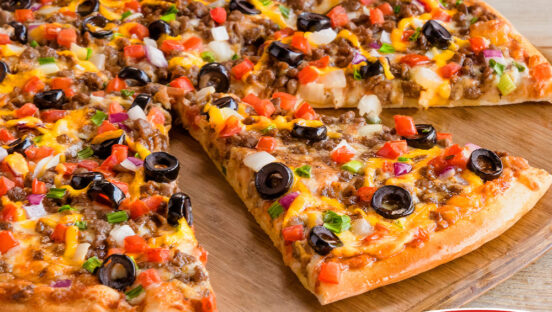- Offering gluten-free desserts can help increase your pizza restaurant’s revenue during unpredictable economic times.
- But it’s important to protect your customers by following best practices for preventing cross-contact contamination.
By Lindsey Yeakle, Gluten-Free Food Service (GFFS) Program Manager, Food Safety
For the estimated 3 million Americans with celiac disease and their loved ones, finding restaurants that serve gluten-free desserts can feel like searching for a needle in the proverbial haystack. As the restaurant industry continues to grapple with the economic fallout from COVID-19, gluten-free diners represent an underserved market for desserts, especially with the holidays right around the corner.
Offering gluten-free desserts is one step pizzerias can take to increase revenue during an unpredictable period, provided you have the setup and expertise to follow best practices for preventing cross-contact contamination.
Related: Adding delicious gluten-free Italian dishes to your pizza restaurant’s menu
Sound difficult? It isn’t. In most cases, you don’t even have to alter your kitchen to serve gluten-free desserts. Many desserts on pizzeria menus—like cannoli, cakes, and gelato and ice cream—can be easily adapted for people who are gluten-intolerant. And a number of bakeries and other suppliers offer gluten-free baked goods, making preparation and service almost effortless.
If you are wondering whether serving gluten-free desserts is worth the time and effort, these three insights provide some persuasive reasons to add them to your holiday menu.
1. Serving gluten-free desserts can increase your check averages—for dine-in and take-out. It almost goes without saying that COVID-19 presents some serious economic hurdles to even the thriftiest of restaurants, and no business wants to leave a potential source of income untapped during slow times. Along with drinks and appetizers, desserts provide an opportunity to upsell. Moreover, people who adopt a gluten-free diet are often willing to pay premium prices because it’s difficult to find desserts they can eat. In addition, most gluten-free diners understand that gluten-free dishes cost more to prepare and are used to paying extra for a treat they really enjoy.
Offering gluten-free desserts to order is another way to increase revenue. During the holidays, many people supplement traditional family recipes with desserts prepared by their favorite restaurants. The holidays also provide the perfect opportunity to promote items with seasonal ingredients like pumpkin spice and cranberries.
2. Gluten-free desserts provide ample opportunities for creativity in the kitchen. When deciding which desserts to put on your gluten-free menu, be adventurous and go beyond standbys like ice cream and gelato. As delicious as ice cream is, it’s often the only gluten-free dessert on the menu. Nine times out of 10, people on a gluten-free diet are craving something different when they go out to eat.
Happily, preparing gluten-free desserts offers many opportunities to get creative in the kitchen with the right ingredients and a little imagination. If you’re wondering where to find gluten-free ingredients, check out the Gluten-Free Certification Organization (GFCO) Product Finder. The GFCO Product Finder, provided by the Gluten-Free Certification Organization (GFCO) and a program of the Gluten Intolerance Group of North America (GIG), is a helpful resource that lists ingredients containing 10 parts per million or less of gluten—a stringent standard that exceeds FDA requirements for gluten-free safety.
In terms of what you can prepare, the sky is the limit. You can bake cannoli filling with or without a gluten-free crust, and crème brulée is naturally gluten-free. Other terrific options include flourless chocolate cake and crustless cheesecakes with cranberry compote or other festive toppings. Another fun idea is the dessert pizza. To make this sweetened variation on a traditional pizza, simply top your gluten-free pizza crust with fruit and sauces. Spiced apple pie filling or peaches and cream are just two delicious ideas for fruit toppings while sauces can include caramel, vanilla, chocolate or Nutella.
When making gluten-free desserts, it’s important to follow best practices for gluten-free food handling. In general, you want to adopt the same practices you employ for making gluten-free pizza crust. For instance, you don’t want to prepare gluten-free desserts where there’s a lot of flour flying around, so be sure you dedicate a section of your kitchen to preparing gluten-free items. You should also store gluten-free desserts on top shelves or in dedicated storage to minimize cross-contact.

Setting up a display of gluten-free pastries with appropriate signage encourages impulse purchasing and can boost your restaurant’s average ticket.
3. Pre-made gluten-free desserts provide a scrumptious, no-fuss option for busy restaurants. Most baked desserts contain gluten, so finding gluten-free recipes that work for your customers can be tricky. Moreover, not everybody has the knowledge and experience to craft gluten-free sweets, and some restaurants may have insufficient kitchen space to create a dedicated area for safe preparation. If any of these scenarios apply to you, consider ordering baked goods from a bakery or supplier that sells gluten-free desserts.
Most gluten-free suppliers are more than happy to work with restaurants, and many offer pre-wrapped desserts that can be stored individually in the freezer. This option is an excellent way to reduce waste and the potential for cross-contact, because you can pull the desserts from the freezer as needed and thaw them in the wrapper until it’s time to plate the dessert and send it out of the kitchen.
When ordering pre-made desserts, make sure you use validated gluten-free bakeries and pastry shops. Gluten-Free Food Service (GFFS) validates bakeries, restaurants and other foodservice establishments. Gluten-Free Gloriously in Stirling, New Jersey, is a GFFS-validated bakery that works with local restaurants and offers a wide array of cookies, cupcakes, cannoli, tiramisu and more.
If you’re ordering packaged goods from a supplier, look for items that are certified gluten-free. The GFCO certifies consumer packaged goods as well as bakeries like Gem City Fine Foods that offer individually wrapped desserts. Rich’s is a GFCO-certified supplier that offers simple, gluten-free dessert classics like cookies and brownies that can be dressed up with gelato, caramel or chocolate sauce and whipped cream.
Related: 7 tips for creating a safe and enjoyable dining experience for your gluten-free customers
The holidays are a time to celebrate with great-tasting food. Desserts in particular offer a mouth-watering way to honor seasonal traditions with friends and family. For restaurants seeking opportunities to increase their volume during this uncertain time, offering gluten-free desserts fills an important need for people with celiac disease and other forms of gluten sensitivity. Whether you serve pre-packaged items or prepare your own concoctions, validating your gluten-free desserts by using certified gluten-free ingredients and suppliers or pursuing validation in your own right will earn the trust of your gluten-sensitive customers and their loved ones to build a loyal following and establish a business model that is evergreen.
Lindsey Yeakle is the Gluten-Free Food Service (GFFS) Program Manager, Food Safety, for the nonprofit Gluten Intolerance Group (GIG). Yeakle has a culinary history working at 4-star and 4-diamond rated restaurants. A celiac disease diagnosis encouraged her to attend culinary school at Indiana University of Pennsylvania Academy of Culinary Arts. In June 2016, Yeakle decided to use her background and education to help the gluten-free community by working with GIG.













